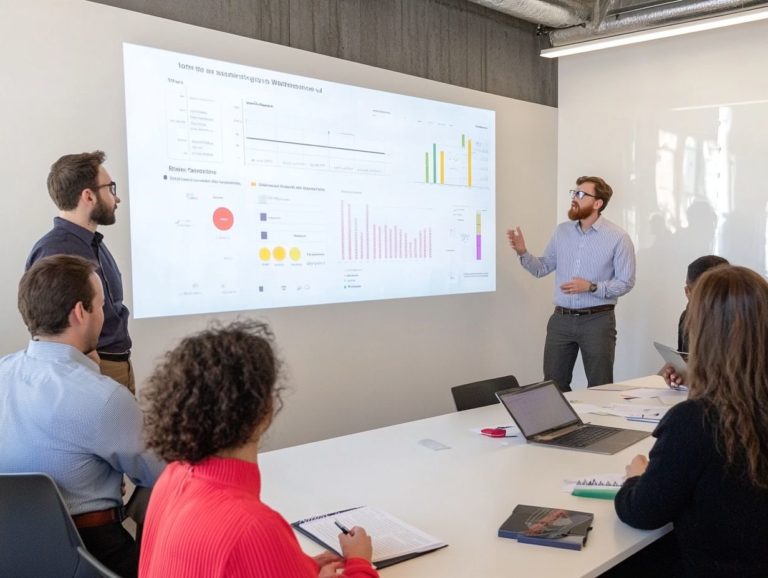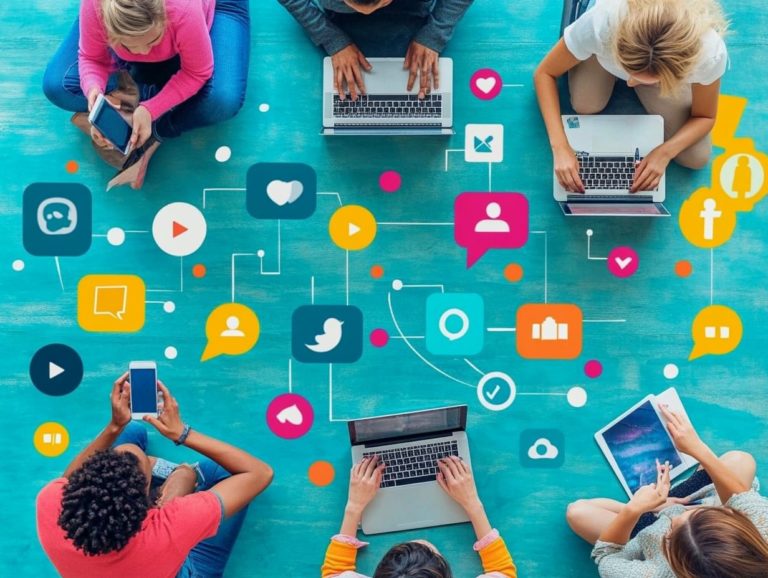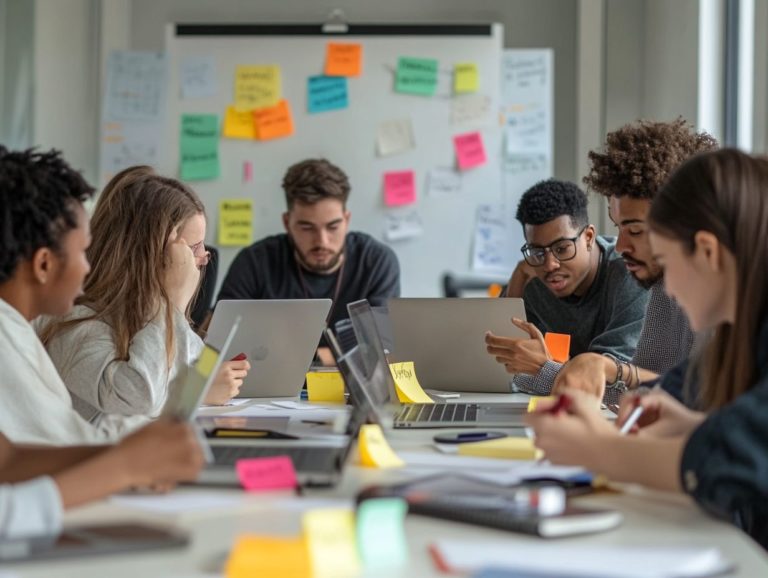5 Tips for Effective Skill Enhancement Communication
Effective communication is the foundation for improving skills. It allows you to share ideas, clarify concepts, and collaborate easily.
Whether teaching a new skill or learning from others, mastering communication can elevate your experience.
This article presents five essential tips to help you engage your audience and convey your message clearly. You’ll explore common barriers to communication and discover strategies to overcome them.
Dive in to unlock the secrets of impactful communication that can transform your learning and teaching journey.
Contents
- Key Takeaways:
- 1. Understand Your Audience
- 2. Use Clear and Concise Language
- 3. Be Specific and Provide Examples
- 4. Use Visual Aids to Support Your Message
- 5. Encourage Two-Way Communication
- How Can Effective Communication Improve Skill Enhancement?
- Your Questions Answered: FAQs on Effective Communication
- Tips for Enhancing Your Communication Skills
- What are some tips for enhancing my communication skills?
- How can active listening improve my communication skills?
- Why is it important to use clear and concise language in communication?
- What should I do if I am unsure about how to communicate effectively with someone?
- How can nonverbal cues affect my communication?
- Why is continuous learning important for enhancing communication skills?
Key Takeaways:

- Understand your audience to tailor your communication for maximum impact.
- Use clear and concise language for better understanding.
- Be specific and provide examples to illustrate your points.
1. Understand Your Audience
Understanding your audience is key to effective communication, especially in diverse workplaces. Recognize the specific needs and preferences of your colleagues to enhance interpersonal skills.
By tailoring your communication strategy, you build stronger relationships and promote clarity in your messaging. This drives success and improves team performance.
Audience analysis is vital for any communication strategy. Emotional intelligence helps you perceive and respond to others’ emotions, aiding in navigating interactions.
Cultural sensitivity allows you to respect diverse perspectives, enriching collaboration. Use active listening and inclusive language to bridge gaps and reduce misunderstandings.
Incorporating visual aids or interactive platforms enhances engagement and promotes clarity among team members.
2. Use Clear and Concise Language
Clear and concise language is essential for ensuring your message is understood. In workplaces with varying expertise, clarity and brevity enhance team performance.
Thoughtful word choice and the right tone are critical. Effective communication relies on expressing ideas simply, avoiding unnecessary jargon that may confuse your audience.
Prioritizing clarity fosters trust and transparency. This encourages open dialogue and collaboration, leading to better outcomes.
3. Be Specific and Provide Examples
Being specific and giving examples can significantly improve audience engagement. This helps build stronger relationships and facilitates effective feedback.
Clearly articulating your thoughts reduces ambiguity. For example, instead of saying, “We need to improve sales,” say, “To boost sales by 10% next quarter, we should target millennial consumers in urban areas.”
Active listening, paraphrasing, and summarizing are crucial for enhancing understanding. These practices promote transparency and build trust among team members.
4. Use Visual Aids to Support Your Message

Incorporating visual aids into your communication strategy can significantly elevate understanding and retention. This enhances effective communication across varied workplace cultures while boosting employee engagement.
Visual aids like charts, graphs, and infographics are invaluable for presenting complex data and ideas in an easily digestible way. By showcasing information visually, you help individuals grasp key points more rapidly, which is especially advantageous in environments with diverse levels of expertise or language proficiency.
These visuals also complement your verbal and written communication and break down information into manageable chunks. They help navigate potential barriers, evoke emotions, and foster connections that text alone often misses, leading to clearer messages and more productive discussions.
5. Encourage Two-Way Communication
Encouraging two-way communication is essential for fostering an open dialogue where feedback flows freely. This approach enhances active listening and improves interpersonal skills among team members.
By nurturing a culture that values input from all levels, you strengthen relationships while building trust and engagement. Many workplaces struggle with communication barriers such as hierarchical constraints and the fear of reprisal that can stifle creativity and innovation.
Tackling these challenges requires establishing solid feedback mechanisms that allow employees to share their ideas and concerns without hesitation. Through regular check-ins, anonymous surveys, and open forums, your organization can promote transparency and inclusivity key elements for boosting morale and enhancing team performance.
When individuals feel heard and valued, their commitment to collective goals deepens, paving the way for a more productive and cohesive work environment.
How Can Effective Communication Improve Skill Enhancement?
Effective communication acts as a powerful driving force for enhancing your skills. It provides essential tools and feedback mechanisms that foster professional growth, cultivate leadership abilities, and promote a culture of continuous improvement. For those looking to refine their abilities further, exploring the top 5 skill enhancement techniques for professionals can be invaluable.
When you feel heard and understood, you naturally engage more actively in your role, leading to greater productivity and involvement. Training programs focused on communication techniques such as active listening (the practice of fully concentrating on what is being said), constructive feedback, and conflict resolution are gaining traction, equipping you and your colleagues with the necessary skills to navigate workplace dynamics.
Consider workshops that simulate real-life scenarios. These provide opportunities to practice communication strategies in a supportive environment, reinforcing your confidence and promoting collaboration. Organizations that invest in these initiatives often witness a direct correlation between improved employee morale and enhanced performance evaluations.
What Are the Common Barriers to Effective Communication?
Common barriers to effective communication can significantly hinder workplace interactions. Factors such as cultural sensitivity issues, misinterpretations, and a lack of clarity can disrupt team dynamics.
These obstacles often lead to misunderstandings, escalating tensions, reducing morale, and decreasing productivity among team members. For instance, when individuals come from diverse backgrounds, cultural nuances can inadvertently cause offense or confusion. Ambiguous language in emails or meetings can lead to misinterpretation of intentions or directives, making collaboration more challenging.
To overcome these hurdles, organizations should establish a culture built on trust and transparency, which involves:
- Provide regular training on effective communication skills,
- Encourage open dialogue,
- Actively seek feedback to ensure every member feels valued and understood.
How Can One Overcome These Barriers?

To overcome barriers in communication, implement strategies focusing on the ability to understand feelings and active listening among team members.
These strategies can greatly improve interactions, fostering an atmosphere of understanding and respect. Encourage everyone to express their thoughts openly while remaining receptive to differing viewpoints to cultivate better relationships within the team.
Honing negotiation skills is essential for navigating disagreements and finding common ground. Practicing these skills enables you to resolve conflicts amicably, ensuring that all voices are acknowledged and heard.
Create an environment where feedback is welcomed and valued. This enables your team to work collaboratively towards solutions, ultimately boosting overall productivity and morale.
What Are the Different Types of Communication Styles?
Understanding the various communication styles both verbal and nonverbal is essential for honing your interpersonal skills, especially when enhancing leadership within teams.
In the workplace, recognizing how individuals express themselves can greatly influence team dynamics and collaboration. For example, an employee who thrives on direct communication may feel frustrated with a colleague who prefers a more indirect approach. This gap can easily lead to misunderstandings.
Cultivating awareness of these diverse communication styles helps your team build stronger relationships. Members will learn to tailor their approaches based on each person s preferences, fostering adaptability. This flexibility strengthens stakeholder relationships and creates a cohesive work environment where every voice is appreciated. Ultimately, this drives productivity and sparks innovation.
How Can One Adapt Their Communication Style for Different Audiences?
Adapting your communication style for different audiences is crucial for ensuring effective interaction. It requires awareness of audience preferences, cultural backgrounds, and the nuances of both verbal and nonverbal cues, such as body language.
When engaging with younger audiences, leverage technology and informal language to create a stronger connection. In contrast, communicating with senior stakeholders often necessitates a more formal tone and comprehensive analysis.
Recognizing cultural nuances like appropriate eye contact or gestures can profoundly impact how your messages are received. Employ techniques such as active listening and establishing feedback loops to foster an atmosphere of inclusion and respect among multicultural team members, promoting a collaborative environment where everyone feels valued and understood.
Incorporate visual aids or storytelling to bridge gaps in understanding across diverse groups, enhancing overall communication.
What Are the Best Practices for Effective Communication in Skill Enhancement?
Transform your workplace culture today by implementing powerful communication practices! Establish structured communication training programs based on the best practices for skill enhancement programs to enable employees to express their ideas and feedback more openly, creating a collaborative environment that thrives on shared insights.
Establish performance evaluation processes that emphasize communication skills to encourage open dialogue. These practices foster understanding among team members and build trust and respect essential ingredients for a productive workplace.
Investing in these communication strategies enhances individual performance while paving the way for a more cohesive team dynamic. This ultimately leads to innovative solutions and improved productivity across the board.
Start your journey to better communication now implement these strategies today!
Your Questions Answered: FAQs on Effective Communication

Tips for Enhancing Your Communication Skills
What are some tips for enhancing my communication skills?
To enhance your communication skills, practice active listening and consider exploring how to facilitate effective skill enhancement sessions. Use clear and concise language to express your thoughts.
How can active listening improve my communication skills?
Active listening means fully focusing on the speaker. This builds rapport and makes communication more effective.
Why is it important to use clear and concise language in communication?
Using clear and concise language prevents misunderstandings. It helps your message get across quickly and easily.
What should I do if I am unsure about how to communicate effectively with someone?
If you’re unsure how to communicate, ask for feedback. This will help you understand the other person’s style and adapt your approach.
How can nonverbal cues affect my communication?
Body language and tone significantly affect communication. Be aware of your own cues and try to understand those of others.
Why is continuous learning important for enhancing communication skills?
Communication is a skill you can always improve. Continuous learning, such as exploring 5 ways to promote skill development in your team, keeps you updated on new techniques and helps you adapt.






